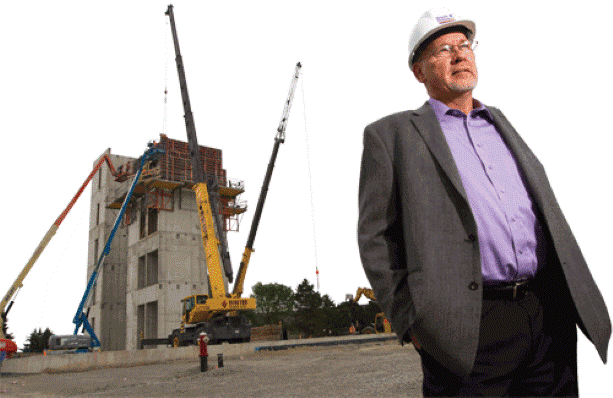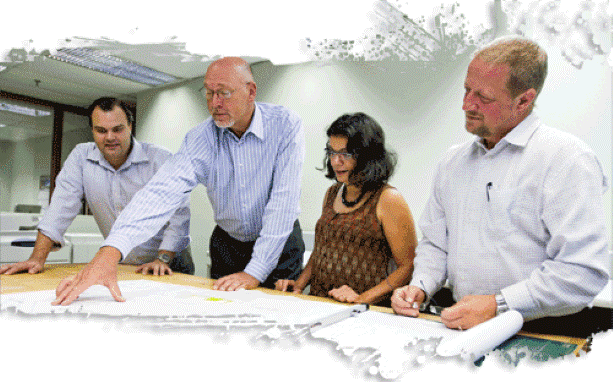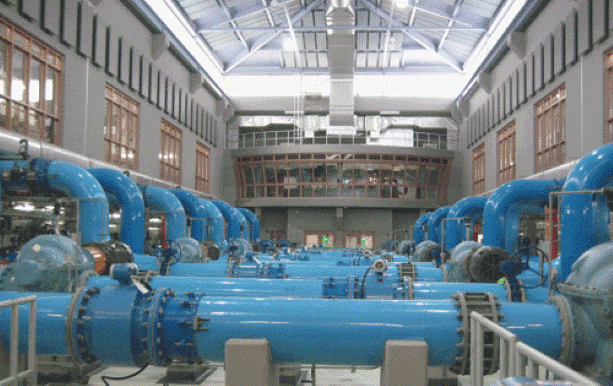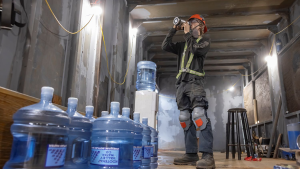The Maple Reinders “way” can be summed up in just those four words but the focus for the $300-milllion construction company is even simpler: be recognized as a contractor of excellence.
Excellence.
Trust.
Improvement.
Growth.
The Maple Reinders “way” can be summed up in just those four words but the focus for the $300-milllion construction company is even simpler: be recognized as a contractor of excellence.
“It all comes down to how our people are engaged in our company. This company is all about people and people are what drives us. We have a high level of engagement, values, honesty and ethics,” says Mike Reinders, Maple Reinders president. “Those are values that my father Fred had when he started the company and they continue to this day. Commitment to excellence is not about who is right, it is about what is right.”
There is no doubt that the foundation for the Maple Reinders “way” and its value system began in Holland in the 1950s with its founder Fred Reinders. The elder Reinders, now 81-years-old, was an engineer and had worked on marine projects in Holland. He immigrated to Canada in the 1950s and worked on the St. Lawrence Seaway. He completed one last year of schooling at the University of Toronto in order to be fully recognized as an engineer in Canada. Then he started his own company in 1967, Maple Engineering and Construction in Toronto.
“It was a nice Canadian-sounding name on Canada’s centennial,” explains Reinders. “Also, in 1967, Fred started an engineering company called FJ Reinders and Associates. They were a consultant that did buildings and hangars such as the old Ward Air one at Toronto Island’s airport and many others across Canada, even internationally in Dubai.”
Maple Engineering and Construction started with marine work on docks and wharfs and when these projects became scarce the elder Reinders decided to bid a sewage pump station project which required concrete, earthwork and piping elements. When recalling those early days of Maple Reinders, its current president remembers clearly his first job in the company that he would eventually lead by 1990.
“I would deliver coffee to the estimator because it all started in the basement of our house,” says Reinders. “We had to tiptoe around the house and bring a cup of coffee downstairs.”
From these humble basement-bound beginnings Maple Reinders would grow to now employ approximately 370 employees with six offices nationwide, stretching from Kelowna, B.C. to its head office in Mississauga, Ont. The company’s bedrock is still its sense of family and loyalty, with Harold Reinders, Mike’s younger brother, as the company’s vice-president and long-time employee John Haanstra, senior vice-president, environmental, who has been with the company since 1971.
Maple Reinders’ president credits the company values of community and family to his father’s strong Christian faith. The company donates 10 per cent of its earnings to various charities across Canada.
“We are very involved in our church and community so we apply that to business as well. Those values of integrity, ethics and giving back to people and the community around you are very important,” explains Reinders. “We encourage our employees to give back in many different ways. From going on a mission to Guatemala to build a school, to serving locally in a soup kitchen or joining Habitat for Humanity to build a house, these values continue to work through our company and they are a part of our culture.”
Mentoring employees to become leaders and to have a sense of social responsibility begins in the employee search itself. The company regularly hires co-operative education students to train and seeks out young professionals that they can mentor. The leadership Maple Reinders executes starts with its people.
“We look for people that fit into the Maple Reinders way,” said Reinders. “We have a structured mentoring program where we identify people in the company that we think will have a leadership role in the future. We are rolling out a new program called ‘The President’s Crew,’ where we will identify future leaders, challenging them to join this program and take on new responsibilities and specific training for leadership.”
The company also has a structured training centre, The Maple Reinders Centre of Learning, to help seed and shape leadership among its employees. There are over 100 different programs offered through the centre, ranging from safety to superintendent training.
Nurturing a culture of leadership and openness has helped Maple Reinders become recognized as one of the 50 best managed companies in Canada. It also is one of the 50 best small and medium employers in Canada, for a company with 500 employees or less, by AON Hewitt and Queen’s University.
“I always say to our employees that every one of them is a manager,” says Reinders. “When we are recognized as one of the best managed, it means all of us are managing our different areas extremely well. It is not that upper management is managing so well, it is everyone doing their job. We must continue to do that.”
The company is now just over 20 per cent employee-owned and a large number of employees are Gold Seal Certified (GSC).
“For employees who have not had the necessary schooling, we encourage them to become Gold Seal Certified and we make a big deal of it,” says Reinders. “We present them with a gold hardhat, display their certificate and make sure they have the GSC on their business card. We also have LEED (Leadership in Energy and Environmental Design) certified professionals as well. We need to continue to promote excellence in the construction industry and this is one way to do it.”
The company’s own path to excellence can be tracked to some of its early business and project decisions. Fred Reinders’ decision to create the consultancy company of FJ Reinders and Associates helped establish the company’s bedrock of experience in design-build construction.
“Maple started doing buildings in the early 1980s. At that time revenue was $3 million a year,” says Reinders. “We grew into the primary areas of buildings and environmental facilities. Through the 1980s we started getting into design-build buildings because we had this consulting firm.”
By the 1990s the company had done its first design-build water and wastewater treatment plant. As the company grew it achieved a balanced presence in both Eastern and Western Canada, in public and private sector work and became a buildings and environmental contractor of note. Throughout it all, design-build has been its backbone.
“We used our skills from one area of construction and applied it to other areas,” he says. “We have probably done more design-build water and wastewater treatment plants than any other contractor. We have been doing them since then across Canada. We just started a $60 million one in Halifax.”
Maple Reinders’ internal development of candour and openness are key contributors to the company’s success in the design-build landscape, finds Reinders.
“A lot of times we know about the constructability of the project and how things can be done more efficiently and cheaper,” says Reinders. “You have to work with the consultants and hear what they are saying and hear what the owner wants. You also have to hear what the subtrades want and know what they can bring to the table as well. If you do all that well, it works out.”
For a typical large design-build project Maple Reinders will hold an all-day partnering session with a facilitator, a concept the US Army Corps of Engineers started in the 1980s and Defence Construction Canada initiated in the 1990s.
“All stakeholders are put together into a hotel for a day or so and you come up with a partnering agreement with a conflict resolution agreement,” explains Reinders. “You have continuing partnering meetings throughout the life of the project. It fits like a glove because of how we operate.”
An innovative organic waste composting plant built by Maple Reinders in Hamilton, Ont. was a design-build-operate project. Reinders noted that the company continues to operate it now and partnering meetings are still held. This plant also exemplifies another area that really excites the company: innovation.
“It is world-renowned because no odours come out of it, it is a totally enclosed building,” explains Reinders. “All the green waste from the Hamilton and Halton areas, some 80,000 tonnes of it, come into that facility. Within a month it is brown dirt. The plant uses European technology imported and applied here.”
Reinders says the company continues to excel at importing and applying new technologies.
“In Richmond, B.C., we are building a project that generates gas and electricity from organic waste. We have built a few in Ontario too,” he says. “Again, it is European technology being applied here. We are very bullish on that. Technology is a big part of innovation. The cost and scheduling controls we have improve the efficiency of how we do our projects. The technology of construction now, the materials that are being used and the new methods of how to construct are exciting.”
The western Canadian toeholds for Maple Reinders expansion to the region have beginnings in the relationship and leadership attributes of Fred and Mike Reinders. It all started 20 years ago with Kings Christian College in Edmonton, Alta.
“Fred was on the board there. They needed some help to build a school and we said we can do it. Eventually we established an office in Edmonton and carried on with a subsequent one in Calgary. We have a great balance of buildings and civil environmental work in Alberta.”
The company is in the process of its first P3 (public-private partnership) wastewater treatment plant in Lac La Biche, Alta. Another western toehold for Maple Reinders came soon after Mike Reinders returned to his father’s company in Ontario in 1981 after working in Vancouver.
“I worked there for a couple of years and made some good friends in the industry. When Fred asked me to come back I came back as project manager. I introduced him to a few of my new western friends and subsequently he hired them and started an office there for us. Some of them are still with the company to this day.”
It is that type of steady approach of identifying opportunities and expanding the company’s footprint nationwide that really excites Reinders. From a massive warehouse project in Edmonton, to the innovative organic waste facility in Richmond, B.C. or building DuPont’s new office building in Mississauga, Ont., the flexibility in Maple Reinders’ operations contribute to its growth and strengths. It also is engaged in the expansion of the Lorne Park Water Treatment Plant, a long-term, five-year project that builds on the company’s solid heavy civil construction resume.
“We are expanding into different areas and new levels of projects. We have managed projects up to $100 million to the satisfaction of all those involved,” noted Reinders.
Reinders says that though his company is not “a big giant” it certainly is a growing one with exciting prospects and visions both internally and industry wide.
“We have a balance between our buildings and environmental facilities. We want to do excellent work and be service driven. We want to be a trusted partner. On all our projects we try to partner with everyone, all the stakeholders, from the owners to the subcontractors and suppliers,” says Reinders. “We want to continually mentor, grow and to reward with good pay. Those are the best investments for the future. If we do all those things well, the bottom-line is, we will be profitable. It does work.”
High-profile projects
The versatility in Maple Reinders construction abilities across Canada can be seen in the following highlighted projects from the company’s portfolio of works:
■ Vernon Water Reclamation Centre
Maple Reinders was engaged as program manager on the replacement and expansion of Vernon, B.C.’s water reclamation plant. Among the various requirements of this project were the construction of a new biological nutrient removal plant, headworks building, biosolids thickening/dewatering building, administration/laboratory building, utility building and related siteworks, including piping, road works and landscaping.
■ Guelph organic waste processing plant
Designed and built by Maple Reinders, the facility is only the fourth Gold Seal Project in Ontario. The facility uses aerobic, in-vessel composting technology and is designed to process 30,000 tonnes of organic material per year. Environmental controls incorporated into the design include air curtains on bay doors and a closed-top design with a 47.5 metre-tall biofilter stack.
■ G8 Summit Kananaskis
Maple Reinders provided construction services for the G8 Summit held in Kananaskis, Alta. in June 2002. A crew of 70 construction workers built six different venues for the conference in just four-and-a-half days. Two months of meticulous planning preceded site mobilization of the crew. Environmental concerns were paramount and the entire project generated only one bin of garbage for disposal.

1/3
2011 Leaders
2/3












Recent Comments
comments for this post are closed